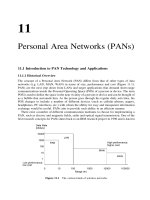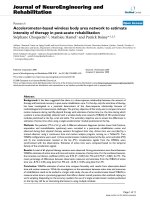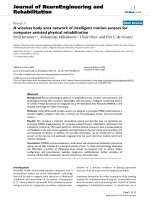High Rate Wireless Personal Area Networks
Bạn đang xem bản rút gọn của tài liệu. Xem và tải ngay bản đầy đủ của tài liệu tại đây (404.85 KB, 45 trang )
Wireless Communications
Chapter 6
High Rate Wireless Personal Area
Networks
Wireless# Guide to Wireless Communications 2
Objectives
•
Define a high rate wireless personal area network (HR
WPAN)
•
List the different HR WPAN standards and their
applications
•
Explain how WiMedia and UWB work
•
Outline the issues facing WPAN technologies
•
Describe the security features of each HR WPAN
technology
Wireless# Guide to Wireless Communications 3
High Rate WPAN Standards
•
IEEE is currently working on two standards
–
IEEE 802.15.3 and 802.15.5
•
IEEE 802.15.3 standard
–
Defines the specifications for HR WPANs supporting
speeds of 11, 22, 33, and up to 55 Mbps
•
In the 2.4 GHz ISM band
Wireless# Guide to Wireless Communications 4
802.15.3 High Rate WPANs
•
IEEE standard defines the MAC and PHY layers
•
WiMedia Alliance
–
Formed to support the development of any necessary
higher-layer protocols
•
And software specifications for 802.15.3
•
Potential applications
–
Connecting digital cameras to printers and kiosks
–
Connecting laptops to multimedia projectors and sound
systems
Wireless# Guide to Wireless Communications 5
802.15.3 High Rate WPANs
(continued)
•
Application characteristics
–
Require high throughput
–
Transceiver should be low-power
–
Cost should be low
–
Require quality-of-service (QOS) capabilities
–
Connections should be simple and automatic
–
Devices should be able to connect to multiple other
devices
–
Security features should be included
Wireless# Guide to Wireless Communications 6
WiMedia Protocol Stack
•
WiMedia group defined two different architectures
–
For the upper layers of the protocol stack
–
One is used for multimedia audio/visual applications
and the other for data transfer applications
•
The lower two layers of the stack (MAC and PHY)
–
Are implemented in hardware
•
802.15.3 PHY layer
–
Converts data bits into a modulated RF signal
–
802.15.3 standard uses the ISM 2.4 GHz band
Wireless# Guide to Wireless Communications 7
WiMedia Protocol Stack (continued)
Wireless# Guide to Wireless Communications 8
WiMedia Protocol Stack (continued)
•
802.15.3 PHY layer (continued)
–
Supports two different channel plans
•
A coexistence channel plan
•
A high-density channel plan
–
Channels are limited to 15 MHz bandwidth
–
IEEE 802.15.3 standard specifies five data rates
•
11 Mbps, 22 Mbps, 33 Mbps, 44 Mbps, and 55 Mbps
–
Trellis code modulation (TCM)
•
Encodes the digital signal so single bit errors can be
detected and corrected
–
Also called error correction (FEC)
Wireless# Guide to Wireless Communications 9
WiMedia Protocol Stack (continued)
Wireless# Guide to Wireless Communications 10
WiMedia Protocol Stack (continued)
•
Modulation
–
See Table 6-2 for modulation techniques
–
Enhancements
•
Passive scanning
•
Dynamic channel selection
•
Ability to request channel quality information
•
Link quality and received signal strength indication
•
Transmit power control
•
An 802.11 coexistence channel plan
•
Lower transmit power
•
Neighbor piconet capability
Wireless# Guide to Wireless Communications 11
WiMedia Protocol Stack (continued)
Wireless# Guide to Wireless Communications 12
802.15.3 Network Topology
•
Piconet coordinator (PNC)
–
Role assumed by the first device in the area
–
Provides all of the basic communications timing in a
piconet
–
PNC sends a beacon
•
The piconet is peer-to-peer
–
Devices can transmit data directly to each other
•
The PNC is also responsible for managing QoS
•
Devices can form a dependent piconet
Wireless# Guide to Wireless Communications 13
802.15.3 Network Topology (continued)
Wireless# Guide to Wireless Communications 14
802.15.3 Network Topology (continued)
•
Types of dependent piconets
–
Child piconets
•
Useful for extending the coverage of a piconet
–
Neighbor piconets
•
Allow coexistence with other piconets in the same area
Wireless# Guide to Wireless Communications 15
802.15.3 Network Topology (continued)
Wireless# Guide to Wireless Communications 16
802.15.3 Network Topology (continued)
Wireless# Guide to Wireless Communications 17
Additional MAC Layer Functionality
•
The IEEE 802.15.3 MAC layer functionality
–
Connection time (association) is fast
–
Devices associated with the piconet can use a short,
one-octet device ID
–
Devices can obtain information about the capabilities of
other devices
–
Peer-to-peer (ad hoc) networking
–
Data transport with QoS
–
Security
–
Efficient data transfer using superframes
Wireless# Guide to Wireless Communications 18
Additional MAC Layer Functionality
(continued)









